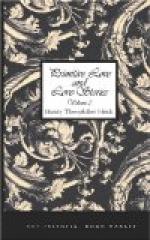[252] U.S. Geogr. and Geol. Survey of Rocky Mt. Region, IX., 90.
[253] Related in G. White’s Historical Collection of Georgia, 571.
[254] See Brinton’s The American Race, 59-67, for an excellent summary of our present knowledge of the Eskimos (on the favorable side).
[255] Journal Ethnol. Soc., I., 299.
[256] Cranz, I., 155, 134; Hall, II., 87, I., 187; Hearne, 161.
[257] Hall, Narrat. of Second Arctic Exp., 102; Cranz, I, 207-12 (German ed.); Letourneau, E.d.M., 72.
[258] Among the Nagas, we read in Dalton (43), “maidens are prized for their physical strength more than for their beauty and family;” and the reason is not far to seek. “The women have to work incessantly, while the men bask in the sun.”
[259] Shortt in Trans. Ethnol. Soc., N.S., VII., 464.
[260] For our purposes it is needless to continue this list; but I may add that of the very few tribes Westermarck ventured to claim specifically for his side, three at any rate—the Miris, Todas, and Kols (Mundas) do not belong there. The state of mind prevalent among the Miris is indicated by Dalton’s observation (33) that “two brothers will unite and from the proceeds of their joint labor buy a wife between them.” In regard to the Todas, Westermarck apparently forgot what he himself had written about them on a previous page (53), after Shortt:
“When a man marries a girl, she becomes the wife of his brothers as they successively reach manhood, and they become the husbands of all her sisters, when they are old enough to marry.”
To speak of “liberty of choice” in such cases, or of the marriage being only “ostensibly” arranged by the parents, is nonsense. As for the Kols, what Dalton says about the Mundas (194) not only indicates that parental interference is more than “ostensible,” but makes clear that what these girls enjoy is not free choice but what is euphemistically called “free love,” before marriage:




